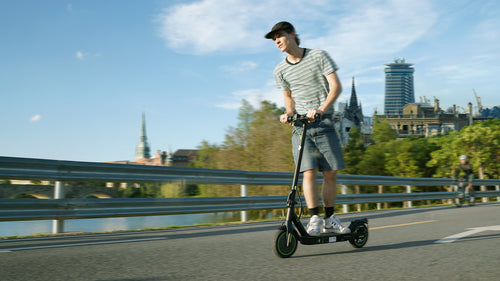
Why Do Cyclists Shave Their Legs?
Shaving legs is common among cyclists, triathletes, and e-bike riders, but it’s not just for aesthetics. Smooth legs for cycling provide practical benefits, including better performance, easier recovery, and improved hygiene. This guide explains why cyclists and e-bike riders shave their legs and offers tips for leg shaving for cyclists.
Why Cyclists and E-Bike Riders Shave Their Legs
Cyclists shave their legs for a mix of practical, performance, and cultural reasons. From improving massage effectiveness and aiding injury treatment to offering measurable aerodynamic benefits and displaying the results of hard training, smooth legs serve multiple purposes. Whether you choose to shave or not, the most important thing is your enjoyment of the ride — leg hair or no leg hair, you’re still a cyclist.
1. Easier and More Effective Recovery
One of the main reasons cyclists shave their legs is for muscle recovery and massage benefits. For those who receive regular sports massages, hairless legs make the process smoother, less painful, and more effective. Massaging over stubbly legs can be uncomfortable and even irritating — some massage therapists compare it to rubbing a cactus!
Even if you don’t get professional massages, shaving can still help with self-massage and foam rolling. Without hair, the roller glides more smoothly over the skin, allowing better pressure on muscles and reducing friction. While shaving isn’t strictly necessary for recovery, it can enhance the comfort and effectiveness of post-ride therapy.
2. Easier Treatment of Injuries
Another practical reason for shaving is road rash management. Cyclists are at risk of falls and scrapes, and cleaning dirt, grit, and debris from wounds can be extremely painful — especially if hair gets caught in the process. Hairless legs simplify the cleaning process, make dressing wounds easier, and reduce pain when removing bandages.
Of course, the likelihood of needing this benefit depends on your riding style. Casual cyclists or those who primarily train on smooth roads may rarely crash, but for competitive riders, group racers, or those tackling technical descents, shaving can be a sensible precaution.
3. Aerodynamic Advantage
For performance-focused cyclists, shaving legs can offer a measurable aerodynamic benefit. Recent wind tunnel studies have confirmed that hairless legs reduce drag, particularly over long distances. One study found that across 40 kilometres, six cyclists of varying hairiness shaved their legs and gained an average time saving of 70 seconds.
Interestingly, shaving arms had minimal impact — only about 11 seconds saved — and facial hair made no noticeable difference at all. While the aerodynamic gains might not turn every ride into a race-winning effort, for competitive cyclists, every second counts.
4. Cultural and Aesthetic Reasons
Beyond the practical benefits, shaved legs have a strong cultural significance in cycling. They are often seen as a badge of honour, symbolising dedication, hard training, and membership in the cycling community. Hairless legs highlight muscle definition, surface veins, and the results of rigorous training, making a cyclist’s physique more visually apparent.
That said, shaving is by no means a requirement to be a cyclist. Many riders choose not to shave and still enjoy the sport fully. It’s more about personal preference, style, and the sense of belonging to cycling culture than a strict rule.
How to Shave Your Legs Like a Cyclist
Step 1: Clip Hair Short
Start by trimming your leg hair with clippers or an electric trimmer. Shorter hair makes shaving easier, prevents the razor from clogging, and reduces the chance of cuts or irritation. This step is especially important for riders with thick or dense hair.
Step 2: Soften Hair with Warm Bath
Soak your legs in a warm bath or shower for several minutes. Warm water softens the hair and opens pores, making shaving smoother and reducing the risk of razor burn. Adding a few drops of baby oil or shower oil can further soften hairs and improve glide.
Step 3: Use a Quality Razor
Invest in a multi-blade razor with a lubricating strip. A high-quality razor provides a closer shave, glides more easily over the skin, and minimizes cuts and bumps. Avoid cheap disposable razors, as they can tug at the hair and irritate the skin.
Step 4: Shaving Technique
Apply a generous amount of shaving cream or gel, then shave using smooth, even strokes in the direction of hair growth. Rinse the blade frequently to prevent clogging and maintain an even shave. Take your time around knees and ankles, where hair is thicker or skin is more sensitive.
Step 5: Moisturize
After shaving, pat your legs dry and apply a nourishing moisturizer. Moisturizing helps reduce redness, prevents dryness, and keeps skin soft, which is important for both comfort and recovery after cycling.
Step 6: Regular Maintenance
Shave once or twice a week, depending on hair growth and your cycling schedule. Regular maintenance keeps legs smooth, ensures massages and recovery treatments are effective, and maintains the professional look associated with cycling culture.
Alternative Hair Removal Methods for Cyclists
Cyclists looking for smooth legs don’t have to rely solely on shaving. There are several hair removal methods for cyclists, each with unique benefits:
-
Waxing for Cyclists – Waxing provides longer-lasting smooth legs, typically 3–4 weeks. While effective, it can be painful, especially for men with thicker hair. Many cyclists opt for professional salon treatments for the best results.
-
Hair Removal Creams – Quick and convenient, hair removal creams offer temporary results. They are ideal for cyclists who want smooth legs without frequent shaving, but some creams may irritate sensitive skin.
-
Epilators – Epilators remove hair from the root, keeping legs smooth for 2–3 weeks. Cyclists may find the process uncomfortable at first, but repeated use can reduce pain over time.
-
Laser Hair Removal for Cyclists – Laser treatments provide long-term hair reduction or removal after multiple sessions. This method is perfect for cyclists seeking a permanent solution, though it requires professional treatment and investment.
Conclusion
Cyclists and e-bike riders shave their legs for performance, easier massages, injury care, better hygiene, and tradition. While it offers clear benefits, shaving is optional, and personal preference should guide your choice. Understanding why cyclists shave their legs helps you decide what works best for your riding style.
FAQs
Should I shave my legs as a cyclist in the UK?
Shaving legs is optional, but many UK cyclists and e-bike riders shave to improve cycling performance, reduce friction during massages, and simplify injury care after crashes. It’s a personal choice based on comfort, style, and training goals.
Why do professional cyclists shave their legs?
Pro cyclists shave their legs to gain an aerodynamic advantage, highlight muscle definition, maintain hygiene, and follow long-standing cycling traditions. Smooth legs are seen as a mark of dedication and professionalism in the sport.
Does shaving legs improve cycling performance?
Yes. Studies and wind tunnel tests show that smooth legs can save 48–70 seconds over 40 km by reducing air resistance. Both cyclists and e-bike riders can benefit from this small but meaningful improvement in speed and efficiency.
How often should UK cyclists shave their legs?
Most riders shave once or twice a week, depending on hair growth and riding frequency. Regular maintenance ensures smooth legs for massages, better recovery, and a professional look on the bike.
The Latest Posts
Explore isinwheel products
City E Scooter | Off-Road Scooter
Fastest Scooter | Kids Scooters































































Leave a comment